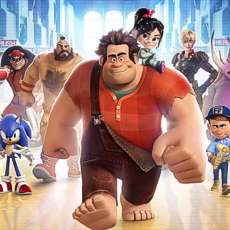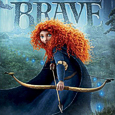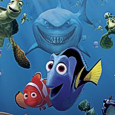Walt Disney Pictures (November 2 2012), Walt Disney Home Entertainment (March 5 2013), Blu-ray 3D plus Blu-ray Disc, DVD and Digital Copy, 101 mins plus supplements, 1080p high-definition 2.40:1 widescreen, DTS-HD , Rated PG, Retail: $49.99
Storyboard:
The mis-understood bad guy from a 1980s video game decides he’s tired of playing villain and so sets out to crash other games in an attempt to prove he can be a hero too.

The Sweatbox Review:
What a paradoxical year it has been at the animated box-office! There have been the usual franchise extensions and franchise wannabes, of course, and now a mainstay of this new CG animated landscape we find ourselves enjoying (or not), and even some independent fare that didn’t really make the kind of impact those kinds of films can do, but top of the heap must be the major offerings from three of the biggest animation companies releasing movies like these today. First up, Pixar’s Brave turned out to be the least Pixar-like feature in their line-up, although as their first outright fairytale-style story it maybe shouldn’t have come as the surprise it was for many.
Arguably the Cars pictures have been the films that have had the hardest time being accepted by the Pixar faithful, although even as much as I didn’t care for them a great jot, I would say that they fit more into the Studio’s mold of taking inanimate or fantasy objects and turning them into talking personalities than Brave ever did, not so much because of the story but because of its tone. If ever a film showcased the merging of Pixar sensibilities with that of their new-ish owners Disney it was Brave, which could have quite easily have been marketed under the Disney name only and still been a hit. (Interestingly, I believe that if that did happen then Brave – a film instigated, of course, by an old Disney hand, Brenda Chapman – wouldn’t have been the success it was and could well have been labelled old-fashioned and Disney-by-numbers, but that’s a whole different debate!)
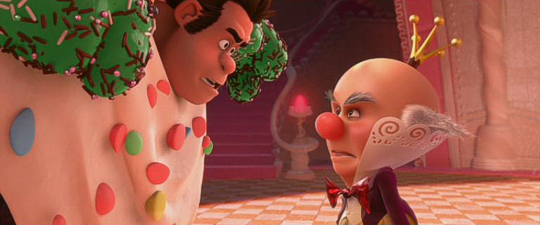
Likewise, over on the DreamWorks campus, Rise Of The Guardians has been described as being the least like a regular DreamWorks Animation picture, by many accounts. I haven’t seen that film yet, but I believe the widely used phrases describing it as a holiday hero’s version of The Avengers aren’t to be trusted and are probably just the kind of lazy shorthand Hollywood can excel at when they want to sell a product by way of something else that’s recognizable and, more importantly, phenomenally successful. Which brings us to Disney’s offering for the year, and their latest film to be created in the CG realm, Wreck-It Ralph…a film that – and you’re probably way ahead of me here before I say it – feels the least like a traditional Disney Animation movie that we’ve had in years.
However, having said that, I also have no idea where Wreck-It Ralph would otherwise feel like it came from! I kind of want to say that it feels like a DreamWorks movie, what with its many pop-culture references and mostly loud action and characters, but it has a little less of a cynical edge to it and a lot more sincerity than most of the films to emerge from that Studio. I don’t think it’s a Pixar film either, even though the production design and really neat little technical touches suggest the same care and attention, and the camaraderie between the blue collar characters in the film shares the same approach as something like Monsters, Inc.
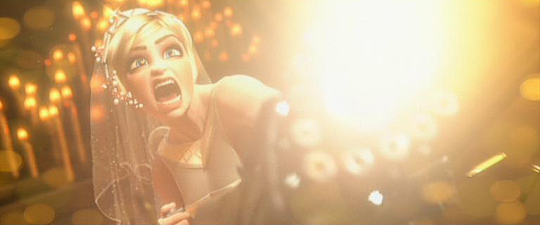
It certainly doesn’t feel like a Disney film, though, at least for its first two thirds, and the only previous movie I can think of to compare it to from the Studio would be Meet The Robinsons from five years earlier, also the first film that then-new Disney chief John Lasseter really got his thumbprints on and had any involvement with. The switch in animation techniques to CGI in the early 2000s really has had an effect on the kinds of films the Disney Studio has ended up making since then, and even the likes of Tangled have a modern sensibility despite their period settings, but Robinsons very much made a point of being different while retaining the classic Disney touch: heart.
Ralph ultimately plays in the same vein, but there are long stretches when I would normally have pinpointed the movie as coming from DreamWorks or, perhaps even more specifically, Fox’s Blue Sky animation unit, the creators of the Ice Age franchise and a handful of other unique films, but otherwise still a studio searching for an identity. The character of Ralph himself is very much in the same situation, looking for a place where he can be himself but also fit in with the rest of his world. He doesn’t have an identity crisis per se, but as the bad guy in an old arcade game Ralph just wants to be accepted by the rest of the 8-bit characters that reside in his world.
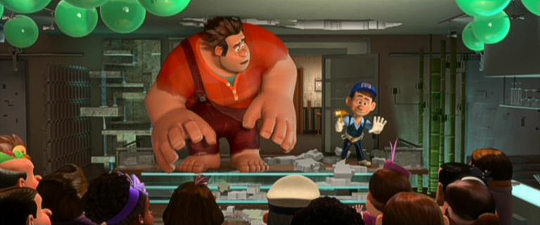
Starting life, like so many animated features do, as a different kind of film altogether, Wreck-It Ralph was once long-time Disney animator Chris Buck’s project Joe Jump, before the Lasseter regime change redirected efforts towards projects that were much more “Disney” in nature. But the idea of a videogame comedy adventure stuck, and possibly inspired by the success of his own Cars, it wasn’t long before Lasseter tapped former Simpsons and Futurama associate Rich Moore and asked him to think about the video game world as being ripe for a Disney animated film. This melding of two pretty far out and removed extremes is probably what, at its core, makes Ralph such a different proposition for the Studio’s long-time fans.
Of course, Disney has explored similar territory before, most obviously with the film that ironically kickstarted the fascination with computer generated images in film, 1982’s Tron. That movie wasn’t a huge box-office hit (and wouldn’t become the kind of cult classic that would warrant a sequel for over 25 years), but Tron did inadvertently lead the inspiration of a wave of young animators and technicians who saw the potential in its then-primitive but still impressive achievements. Tellingly, the film’s Fix-It Felix, Jr is a 30-year old video game that provides the core basis for Wreck-It Ralph, the depicted arcade of which might well have been just like Flynn’s in Tron, a kind of place that was commonplace in the early 1980s, and packed with the latest games that sported then-amazing graphics leagues better than our Atari 2600s could ever hope for.
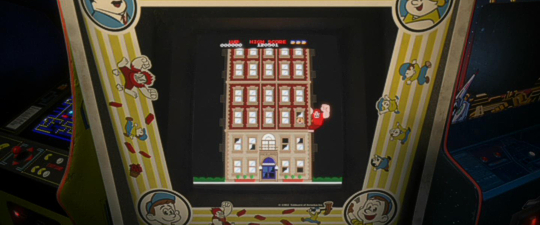
I wasn’t the biggest gamer back in those days, but get me plugged into Space Invaders, Asteroids or Star Wars and I’d regularly be up in the top five toggling the joystick to place my initials among the high-scorers. Soon home computers capabilities began to catch up, and the arcades largely died off with only a few remaining in major populated areas. It’s here that we find Fix-It Felix, an old but still popularly retro game that’s strangely never been upgraded from it’s Donkey Kong style, 8-bit graphics. I did question, for a moment, if kids raised on pixel-perfect shoot-em-ups would really have still been interested in such a game, when many much more advanced diversions scream out from the rest of the arcade’s facades, but the film’s opening pulls off the fact that some of these popular old-time games still have a place along a dusty back wall.
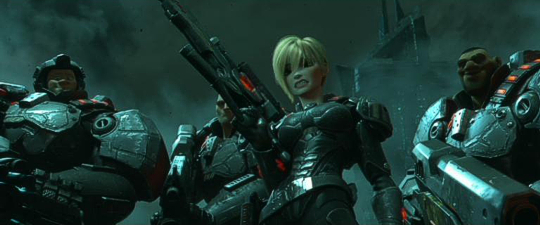
I have to say at this point that it took a while for me to really get to grips with Ralph. I’d heard nothing but good things about the movie and had wished hard that Disney Animation might have pulled off the double feat of winning this year’s Oscar for Best Animated Feature after their Paperman short proved so winning and did eventually nab the Animated Short prize. Alas, it was not meant to be, with Pixar stomping home with their win for Brave, ironically, I felt, since out of all their titles that one did feel the most like a classic Disney picture. The widespread talk that Disney was robbed got me intrigued: I didn’t think Brave was necessarily Academy Award-winning material, but was Wreck-It Ralph really the superior film?
The opening few minutes of the movie doesn’t convince, frankly. After a brief backstory set up, I cringed as a character from a dance machine game turned to alert the rest of the arcade that the lights had gone off and the arcade was theirs for the night, a moment that felt like one of the many Toy Story rip-offs, such as the interminably baaad Food Fight, in which various inanimate objects come to life when the humans leave. Thankfully, Ralph has more to it than that…but only just. Although I did end up enjoying the overall movie, my main concern is that Wreck-It Ralph just feels so derivative of other projects: getting past that initial call back to Toy Story, it’s not long before we release that the movie is, in essence, a re-versioning of many of the same themes.

Not only that, but just as the fledgling Pixar’s relationship with the then-indestructible Disney meant they had the clout to pull a few strings and include cameo appearances from a slew of real-world, old-school toys (the likes of which the filmmakers had grown up with and would, by way of their film’s success, cleverly reintroduce to the market place as “Toy Story merchandise”), the same trick comes off again here. So, alongside Felix, Ralph and characters from other imaginary games the movie features, we also have Sonic The Hedgehog, orange Pac-Man ghost Clyde, throwback Q*bert, Frogger and others, including particular reference to the near immortal Street Fighter. However, these are just that: small, sometimes blink and you’ll miss ’em cameos, and not the co-stars Ralph’s posters and cover art here might have you believe.
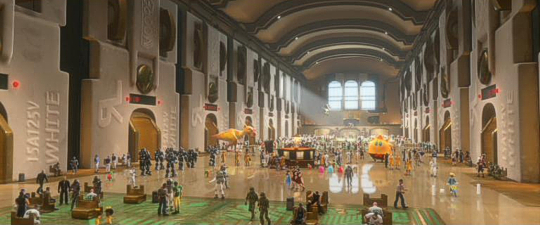
That said, their appearance (and, surely, many of the more major characters to come in a rumored sequel) does bring about an authenticity to Wreck-It Ralph that creates a pretty well realized game universe, one that is connected in the film through the junction-linked Game Central Station, where characters can whizz from game to game though the electrical sockets. It’s a fun concept, so why does it – and a lot of Wreck-It Ralph – feel so “borrowed” from other places? There’s more than a hint of Lasseter’s Pixar feel at Game Central, and even if the further cameos further deepen this universe, I still didn’t quite buy the concept fully: it’s a means to an end, and about as good as any that could probably have been come up with, but I’m just not sure I buy it.
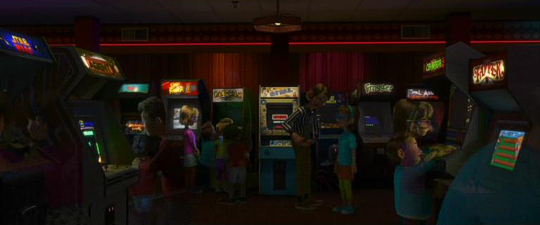
Real-world character cameos have been done before, of course, with Who Framed Roger Rabbit famously packing in the cream of the crop of Hollywood’s golden age of animated characters into its 1940s set story, but in thinking of that movie I wondered how much better Ralph’s universe might have felt if Mr Litwak’s arcade hadn’t been a “real” place populated by live-action humans. It wouldn’t have been outside the realms of a typical Disney animated feature: as far back as Fun And Fancy Free Walt used live-action segments to bookend the illustrated styles of the main animated picture, and I think this could have only helped provide a realistic environment for Ralph’s arcade shenanigans to take place with an extra added layer of authenticity, as well as creating a proper separation between the film’s “real human” caricatures and the arcade characters, which at the end of the day don’t have enough differences between them.

This thinking – occurring mostly during the movie’s first half where I found a lot of the set-up to be slightly laborious – then got me to wondering if it might not have also been cooler had the citizens of Niceland retained their 8-bit appearance too? It feels slightly lazy that, behind the lo-res screens of the early 1980s there actually live characters that look as great as modern-day, 2012 CGI can render. There is a small tip of the hat in their movements being staged along straight lines and devoid of typical Disney “squash and stretch”, complete with jumpy frames that suggest they’re not the full render, but then Felix and Ralph themselves don’t appear to have to endure those same limitations. Indeed, when Ralph breaks out from Fix-It Felix, Jr and enters a typical Halo-style shoot-em-up, Hero’s Duty, he doesn’t look out of place at all, when it might have led to further plot points and technical innovation if he had to keep disguising his lo-res appearance.
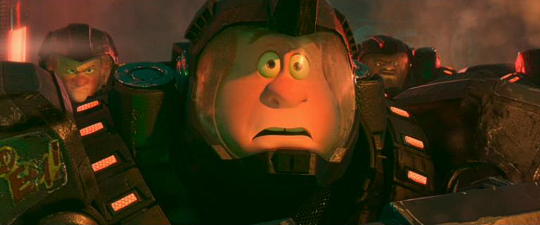
It’s only when Ralph makes it into the third video game environment to dominate the movie, the go-kart speedway gamer Sugar Rush, that Wreck-It Ralph really started to come alive for me. I’d liked how we’d met Ralph, perfectly voiced by John C. Reilly (an actor that, like Ralph himself, is often found in a certain type of role when he can do so much more, and does so here) in his villain’s self-help group (motto: “just because you’re a bad guy, it doesn’t mean you’re a bad guy”). This would have been a wonderfully unique and contemporary way to introduce a new Disney (anti-)hero…had we not recently seen the exact same shtick play out in one of the Toy Story Toons in which rejected fast-food meal toys come to terms with their place in life.
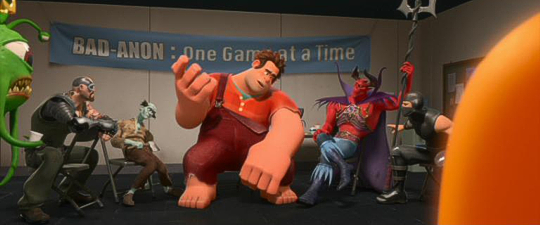
Much better is the introduction of Vanellope von Schweetz (Sarah Silverman), Sugar Rush’s most determined character. Silverman is a polarizing comedienne whose regular stand-up act will either entertain or profusely offend, although I haven’t really seen too much of her to call it either way for myself (for the record, what I have seen, of her self-titled television show, I did find amusing). Certainly she’s a bold choice for a voice in a Disney animated film (after popping up for mere seconds in The Muppets), but then this isn’t your regular Disney animated film. Pop-culture nods and an almost unheard-of (for a Disney picture) amount of product placement is the norm here, in a movie that references videogames so avidly and seems to be intently trying to be anything but a typical Disney picture.
I was worried from the endlessly shown trailers that Silverman would be more irritating than her otherwise cute little character’s visual design suggested, but actually she’s excellent and, once we’re embedded in Sugar Rush’s world, I was finally able to really plug into the movie. It’s here that Wreck-It Ralph’s real plot kicks in, giving the villain the chance to be the nice guy he’s always wanted to be, and plaudits must be awarded to the art direction team – including, somewhat surprisingly, one of the Studio’s long-time artists Mike Gabriel, here proving just how great he is at his art – for coming up with a totally fresh landscape that pays visual homage to Disney’s past while feeling totally part of today’s videogame environments.
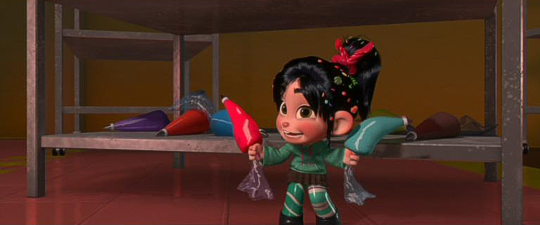
In a digital land totally made up from pieces of confectionary, the supposedly sugar-coated King Candy rules, although his sweet exterior hides a most sinister plot concerning Vanellope. It’s in Sugar Rush that the movie spends most of its time and finds its groove, save for a sub-plot in which the Alien-style insect creatures of Hero’s Duty also crash the game, followed by Duty’s nominal hero Sergeant Calhoun (Jane Lynch) and Ralph’s game’s protagonist Felix (Jack McBrayer), who has also ventured out to find his opponent before Fix-It Felix, Jr is relegated to the out of order list, which can only lead to the certain unplugging of the game!
Silverman still manages to push the envelope, however, with a slightly crude but still big fun take on the Hero’s Duty title, which has to be heard, in a comical sequence where she begins to bond with Ralph. As King Candy, Alan Tudyk, one of the few actors that understands the motion-capture process and can stand shoulder-to-shoulder with Andy Serkis any day of the week, gets a chance to not have to don the ping pong ball-covered leotard, providing another recall to Disney’s past by – intentionally or not – seemingly channelling the wonderful Ed Wynn and reminding us of the Mad Hatter from Walt’s 1951 take on Alice In Wonderland, a film that Ralph occasionally mirrors visually and in tone, proving that even Walt could make a movie outside of what was normally expected of him.
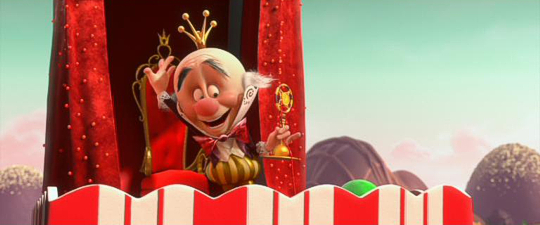
However, for all it’s non-typical Disney approach, Wreck-It Ralph does finally reveal itself to be a Disney picture after all in its third act, even if I was again reminded of another production, Brad Bird’s The Iron Giant, in Ralph’s final, ultimate sacrifice. With the story elements having been explored and then set in place, Ralph’s finale is an exciting one, with the vocal performances really being the factor in bringing heart to the closing moments, again being similar to Meet The Robinsons’ dénouement, in which the otherwise flippant tone revealed a much softer interior, and one that emotionally hit home just when it really needed to. Personally, I was pleased this worked, as if it hadn’t then Ralph could well have been a major disappointment, a movie with a great central act that didn’t have the beginning and the end to support it.
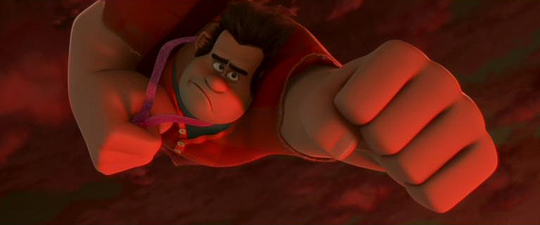
I’m not quite sure what I was expecting with Wreck-It Ralph, and despite my feeling that Brave won the Oscar based on Pixar’s reputation rather than the Academy members actually finding the time to watch each nominee, I’m on the fence as to if Disney should have won it either. The motion picture Academy can be an odd bunch (nominating the otherwise awfully written and badly executed A Cat In Paris last year being one such moment that springs to mind), but overall I do believe we have had a rather challenging year for animated features in general, none of the Oscar-nominated films for 2012-13 could really be called classics in waiting.
Of those other nominations, Tim Burton’s Frankenweenie and Laika’s ParaNorman both proved to be a lifeless disappointments, ironically given their subject matter, and although I believe Aardman’s The Pirates! was the most entertaining picture of the year it did also suffer from being slightly too long and with one or two sections that were too random for their own good. In the end it was pretty tough to call: Brave had been hoovering up prizes from most of the guilds before the Oscars, but Wreck-It Ralph had powered home to nab five wins, including Best Feature and Director, at the industry’s Annie Awards. My take? Brave was a visually breathtaking film that suffered from an overly simplistic story that often went nowhere for long stretches of time.
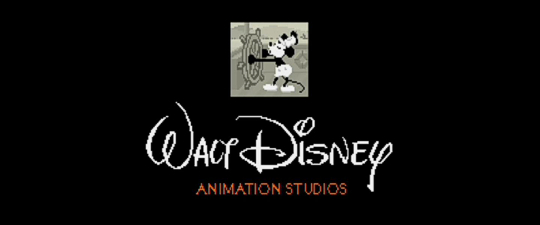
Wreck-It Ralph, on the other hand, and taken at face value without taking into account some of the many grumbles I had with it, is also visually breathtaking but never suffers from being stuck in the same place for too long. On reflection, it is endlessly entertaining and always stimulating the senses, absolutely packed with little touches that ardent videogame players will appreciate. It is a contradiction in terms, however, and in whatever new it brings to the Disney canon, none of these elements are really unique to themselves – even the fun 8-bit opening Disney Animation logo, complete with midi-synth sounding music cue, is an idea lifted from Universal’s similar intro to Scott Pilgrim Vs. The World.
For me, and despite Ralph’s unquestionable amusement value and attention to millions of tiny details, the film could have been much more than the sum of its parts, if only those parts had been more freshly minted. As it is, the whole just about manages to recycle them into something different and, strangely, “new” but without actually being new. It’s a real conundrum, being a hugely entertaining and extremely well made film, ultimately, but one that couldn’t escape, for me, revealing its many sources, points of reference and…let’s say “inspirations”. There is a lot to like: I loved King Candy, even if he did feel like a Mad Hatter throwback (he even says “thilly” for “silly” with that Ed Wynn lisp), and in Vanellope Disney has been smart in making ostensibly a “boy’s movie” but with at least one appealing girl character, with a cool glitch in her backstory.

It’s a stealth-like move: Disney films, especially recently, have traditionally drawn in, and been more accessible in merchandising form, to female fans, hence the acquisition of Marvel to capture more of the male demographic, but here we have a gung-ho, pro-active leader in Calhoun, even if she is – and intentionally so – one dimensional. And far from being the comedy sidekick, Vanellope is highly ambitious, too, even if she does find herself being persecuted by a man and it takes another one to help her achieve her aim, and there conveniently turns out to eventually be much more to her so that she can presumably take her place in one of the Studio’s another girl-ccentric merchandising franchises alongside Belle, Aurora and the others.
Which kind of brings us back to that paradoxical comment. Yeah, there are lots of problems I had with Wreck-It Ralph, some of which I think could have been fixed and made for a much stronger movie…one that might have built more early-awareness hype (after all, little of us had a clue what to expect in the run up to the theatrical release), been a little more anticipated than Pixar’s latest and then actually nabbed that Oscar – and every other prize – outright. I just wish more if its elements had felt fresher or been more unique. However, that said, Ralph’s ultra-contemporary feel is unlike any Disney picture before it, and if there was ever any one film that proves so many wrongs can make a right, then ultimately Wreck-It Ralph is it!
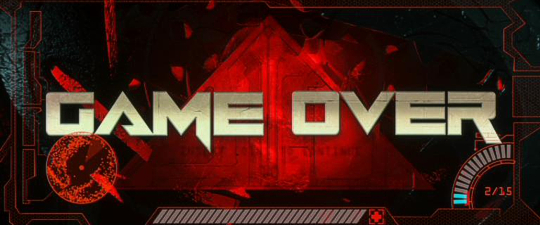
Is This Thing Loaded?
I was really pleased to see Wreck-It Ralph announced as being an Ultimate Collector’s Edition, especially coming after that tag was recently launched on the latest Pixar titles, which proved to be packed with nourishing extra content. Finally a Disney movie – and one which, despite the Oscars, was the Studio’s most outright commercial and critical hit in years – looked like it would be treated with the same level of home video respect that the likes of Brave, Finding Nemo and Monsters, Inc. enjoyed in their Blu-ray collections. However…the reality is much different: this is an Ultimate Collector’s Edition where the Ultimate has been well and truly blasted out of existence.
Far from being a full-featured title with commentary (I won’t even begin to wish for the kind of Cine-Explore presentation that Disney’s Blu-rays used to boast) from the filmmakers, a good bunch of behind-the-scenes production featurettes or longer documentary, and such niceties as concept galleries and theatrical trailers, Ralph becomes just another standard, off the shelf Disney title, with the same old, very basic offerings as a small group of deleted scenes and a general production overview featurette being the only two cornerstones of this “UCE” supplements package. There is slightly more to it than just that, but those expecting a legitimate second Blu-ray stuffed with “more” are not going to find it here.

If the movie wasn’t as good as it was, fans would still probably want to pick Wreck-It Ralph up for the real reason to own this set: the inclusion of this year’s Academy Award winner for best animated short, Paperman, which builds on the hand-drawn feel Glen Keane brought to his Rapunzel project Tangled to mesh CG techniques with hand-drawn sensibilities like never before. The result is easily the most charming of this year’s nominated shorts and almost makes up for Disney not pulling off the double feat of winning for animated feature too; a totally delightful film that plays “silently” as so many of the recent Disney and Pixar shorts have done.
Although Paperman features a contemporary-sounding score, giving it an old-school feel is a production design that finds room for older vehicles and architecture and manages to evoke a classic New York city, while the transfer introduces a level of grain to the image, presumably to create the illusion of additional vintage. But it doesn’t work. Far from feeling inherent in the “print”, as true black-and-white grain structure would, this very much looks like a video-generated overlay, and more like crosstalk noise than actual grain. I was disappointed, having not picked up on that in previous viewings, with the amount subjected on the image actually detracting from the film rather than serving it with any suitable nuance.
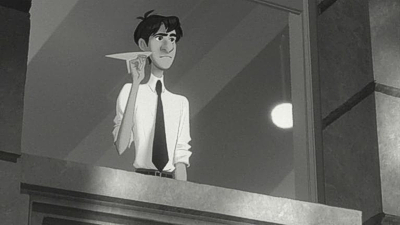
On the enclosed Blu-ray 3D disc, Paperman is pleasingly retained as the platter’s sole extra, and probably because of the way the left and right eye frames just overlap each other, the video noise/grain didn’t seem quite as irritating…plus the added dimension gives the brain more information to process so as to perhaps not notice that aspect as much. However, I didn’t think the added-D brought much to the short, creating a rather flat and layered look to the artwork that I don’t think makes itself known on the non-3D version, and the b/w rendering also seemed to play up some trail/dragging issues whenever a contrasting object moved at any speed. A great cartoon, but not one to really see or remember in 3D, ultimately.
Bit By Bit: Creating The Worlds Of Wreck-It Ralph is the set’s only production overview and, like many such Disney featurettes of the past, it does its job superbly even if one really is left wanting to see and discover so much more. Packing everything into its scant near 17 minutes, Bit By Bit speaks in soundbite mode to the filmmakers, including all of the primary players from director Moore, producer Clark Spencer, writer Phil Johnston and art director Gabriel down, covering the development, characters and design of Ralph and the various game environments in which the movie is set, although true to Disney form there’s naturally nothing on the earlier Joe Jump incarnation.

As always, this is an interesting take on the production (I was especially surprised to hear some speaking so honestly about lifting conceptual and visual ideas from Toy Story and other filmmakers), even if it only makes one wish this group had also contributed a commentary track so as to hear more, although a bunch of Alternate and Deleted Scenes do sport a little bit of info by way of an 8-bit introduction and optional commentary (on these scenes only). Four sequences – Ralph In Hero’s Duty Prison, The Maize Maze, Vanellope’s Volcano and Extreme EZ Livin’ 2 – offer up more Felix, an extra Sims kind of game environment and more of a monster design for Ralph over their 15 minutes’ worth of storyboard and pre-viz animatics, but there’s nothing here that feels it should have been developed for the movie.
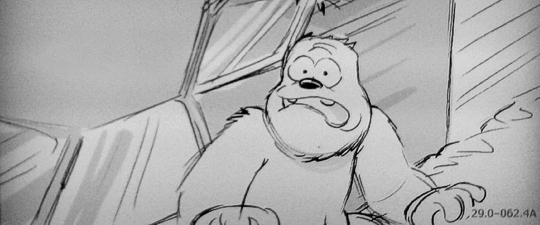
The Disney Intermission is back, but it seems the Studio is already becoming bored with its own innovation (where the viewer pauses the movie but the disc optionally keeps playing secondary entertainment value), since all we get here are around nine minutes’ worth of shorter clips in which self-confessed nerd and comedian Chris Hardwick hosts The Gamer’s Guide To Wreck-It Ralph, a series of 60-second looks at the many real game references, characters and in-jokes to be found in the movie. The clips don’t seem to have been created just for this Intermission feature, and will repeat themselves randomly if the film is paused at various points: surely this might have been better to simply have as a menu option of their own?
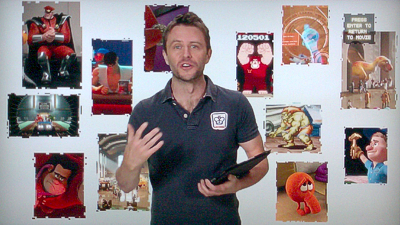
Also fairly slight and inconsequential is a collection of Video Game Commercials, running less than a minute a piece, that present “archival” promos for the three major “games” featured in the movie, including Fix-It Felix Jr, Sugar Rush and Hero’s Duty, plus the “real” Fix It Felix Hammer merchandise spin-off. The first has been created in the same faux-VHS style of Toy Story 3’s Lots-O’-Huggin’ Bear spot, and that is just the very reason it feels old for real: this trick has been pulled before and, as with the Pixar end-credit outtakes that eventually became copied and tired, it’s too close to a re-use of the same idea rather than a fresh take, even if it and the others are fun and quite authentic.

Those game commercials are about as close as we get to anything promoting Wreck-It Ralph itself, since they’re the last of the bonus features! And this being an Ultimate Collector’s Edition! Still, at least the Paperman short has survived onto the also included DVD as that disc’s only bonus, with the usual collection of Sneak Peeks for upcoming titles featuring Monsters University, The Little Mermaid’s Diamond Edition, Who Framed Roger Rabbit, Mulan: 2-Movie Collection Return To Never-Land, the same old Planes spot, and another entry, SuperBuddies, in Disney’s ongoing video franchise.
Case Study:
Sporting a really nice cover, Wreck-It Ralph follows previous Disney 3D editions by using a lenticular card attached to the front of a glossy slipcase, this time given a unique golden hue in place of the usual silver. The Ultimate Collector’s Edition banner along the top naturally proves to be a misnomer considering the limited extras in the set itself, but the 3D lenticular continues the Monsters, Inc. trend of really being worthwhile with the characters, especially Ralph, heading out of the image, mirroring a poster design in which the same line-up emerged from a classic arcade game screen.
I wish they’d kept that imagery here, but the effect is similar and at least the movie retains its proper title instead of having a “3D” added to it. Inside the surprisingly slimline case (instead of the usual thicker cases used for four-disc sets, and another indication of Disney not giving the title the full treatment), fans won’t like the fact that the discs come stacked two on each side of the case, but the booklet and insert are generous and offer up various Ralph promo pages, a cool sweepstakes and a download of Jackman’s Ralph soundtrack score for just over $5 to Movie Reward members.
Ink And Paint:
Okay…you know the drill: this is a 2012 state-of-the-art digitally animated movie coming straight to Blu-ray mere months after playing in theaters (and still doing so around the world, not that Disney’s ABC-zoned disc seems to care about), so it’s going to look great, right? Well, it certainly does, and the amount of clarity and sharpness to the amazingly realized worlds of Wreck-It Ralph just literally pops off the screen – especially in the 3D edition also included here. Both encodes push the BD format to their extremes, but the 3D pushes things even more, the bright colors and nature of the Sugar Rush world making for a terrifically dimensionalized environment. There’s a bunch of demo scenes in here, not least what might happen to Vanellope if she were to try and leave the game, as well as her final race, which is as exciting as they come and, in 3D, is a real visual sugar rush to say the least!
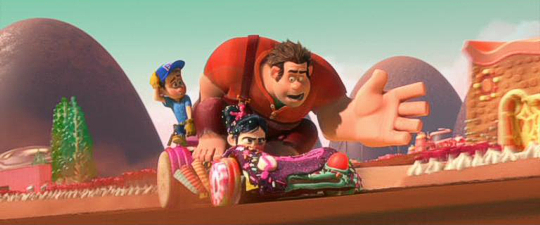
Scratch Tracks:
Part of Ralph’s success is in its authentic feeling videogame atmospheres and helping those along in no short order is composer Henry Jackman’s score, swapping the gentle nature of the Hundred Acre Wood in his last Disney assignment, Winnie The Pooh, for a vastly energetic blend of symphonic orchestral work, rock sensibilities, synthesized pastiche and, yes, 8-bit cheese. It all works brilliantly for each scene but never calls attention to itself, the work of a truly talented composer to listen out for. The rest of the soundtrack is just as top-scoring, from the vocal performances to the mix itself, which pulls out every blip and beep, explosion and blast for a truly enveloping experience. English, French and Spanish dubs and subs are all optional across all discs, although check for minor foreign alterations on the DVD between the US and Canadian editions.
Final Cut:
Do you know what an Ultimate Collector’s Edition looks like? Good, then you’ll know this certainly doesn’t represent or even imitate one. Once again a top-tier Disney title is handled with less respect by its own home video department than is the norm for the glossier films emerging from the Studio’s Pixar division, and it can’t just be me that gets a sinking feeling when the likes of Cars 2 and even Brave receive much more extensive treatment in the way of whole BDs dedicated to documenting their production.
The UCE badge aside, what we get is the usual Disney package of deleted scenes, a single production featurette and a scant few additional promo items…the same kind of deal as has been awarded these kinds of titles since Disney went CG with Chicken Little almost a decade ago. Wreck-It Ralph is a huge step-up from that movie in terms of production prowess and, perhaps for the first time since Tangled, beats Pixar at their own game. The movie may be formulaic, but it somehow manages to take its melting pot and mix the ingredients into a sweet treat.
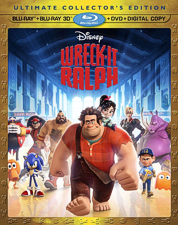 | ||
 |



